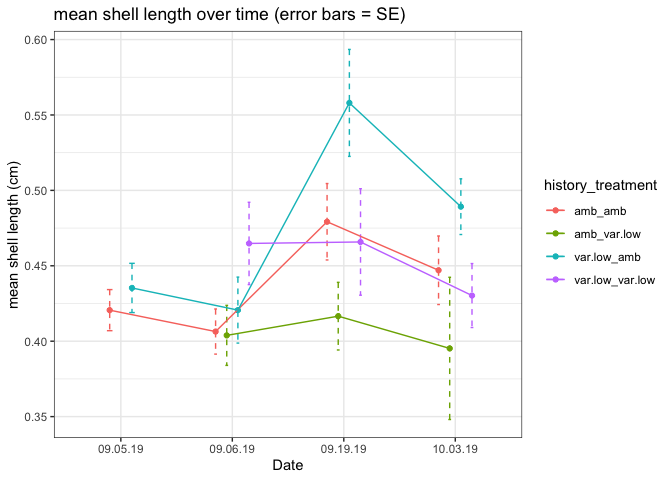Experiment Day 36
- Got to the hatchery at 1pm
Water chem
- Water level in low pH header tank was low again. Spoke with Matt and it’s still unclear what’s going on with the system. He suggested it could be a clog since the source tank is consistently full and is only feeding the totes and the two conicals. It’s just strange that it has now switched from the low pH header tank being low to the ambient heater tote being low, and now back to the low pH header tote being low. Matt suggested these inconsistencies may have been happening this past fall too only not obvious because if the flow slowed the tank would not drain, where now the header totes have pumps so can drain because of that.
Low pH header:
- Took discrete measurements at 1:30pm.
- for TA, I took directly from the discrete measurment water after filtering it through 20uM. The discrete measurement water samples were directly from the headers and inside the silos (using clean TA cups).
- Discrete measurments looked as they should
- I ran TA of 8 samples (4 samples from last week and 4 from today)
- It took a long time to get the acid flushed through the lines without bubbles. It seems like there was air getting in the outflow line from the burette, so I ended up disassembling and reassembling the tubing and burette. Eventually, after 30 flushes, this seemed to do the trick. I will need to change out the HCl next time. I started the TA run around 3:30pm.
- Again, I didn’t take measurments for volitional spawned low pH vs. ambient conditioned juveniles (from Sam’s summer experiment) because I was short on time.
animal check
Var.low pH treatment
ambient offspring:
var.low pH offspring:
Ambient pH treatment
ambient offspring:
var.low pH offspring:
Offspring sibs from var.low and ambient conditioned broodstock
-
these are the left overs after we divied up the offspring at the start of the experiment
- for reference, animals are on 1 mm mesh
- ambient extras were mostly from smaller initial size class
- var.low pH extras were mostly from larger initial size class
2018 juveniles (Sequim bay outplant vs. hatchery reared)
var.low pH treatment
ambient treatment
Growth over time
I did some preliminary analysis on shell length and wet weight data (that I collected for the respirometry trials I’ve done over 28 days) to try to get an idea if either measurement shows a trend over time.
Shell Length over Time

- Markdown summary of analysis here (lines 198-240): Resp.Calculations.ST.md
- R markdown here(lines 198-240): Resp.Calculations.ST.Rmd
- R project here: Respirometry.Rproj
- R analysis directory: https://github.com/shellywanamaker/P_generosa/tree/master/amb_v_varlowpH_juvis/analyses/Respirometry
Conclusions Over 28 days:
- No consistent increase in shell length or wet weight over time.
- This could be due to too small a sample size at each time point. From 9/6/2019 on, sample size = 5 animals.
- Apparent difference in shell length and wet weight between treatments:
- For animals in variable low pH treatment, offspring from variable low pH conditioned parents generally show larger shell length and greater wet weight than offspring from ambient parents
- For animals in ambient treatment, offspring from variable low pH conditioned parents generally show larger shell length and greater wet weight than offpring from ambient parents.
- Offspring from ambient parents in variable low pH treatment show the least growth over time
- Need to confirm these results with larger sample size
Concerns
I am concerned that the var.low pH treatment may be leading to high mortality. The shell clearing I observed in previous weeks seems to continue until there is no shell and the animal dies, as evidenced by the debris in silos 2.1-2.12. These animals are also extremely fragile, so I decided against any cleaning after discussing with Matt. I had originally planned to stop this experiment after 60 days (Oct 31 proposed stop date), however I am concerned to continue much longer if var.low pH treatment is causing high mortality. It’s possible it’s a food thing, and they may need much more food to compensate for the amount of energy they are putting into tolerating the var.low pH condition. I could try pumping more food directly into the headers. Reducing the flow would likely help maintain more food, however turning down the header flow could lead to uneven header tank levels and turning down the flow into the silos reduces the pressure in the manifold leading to uneven silo flow. I will consult with the team about what to do.
